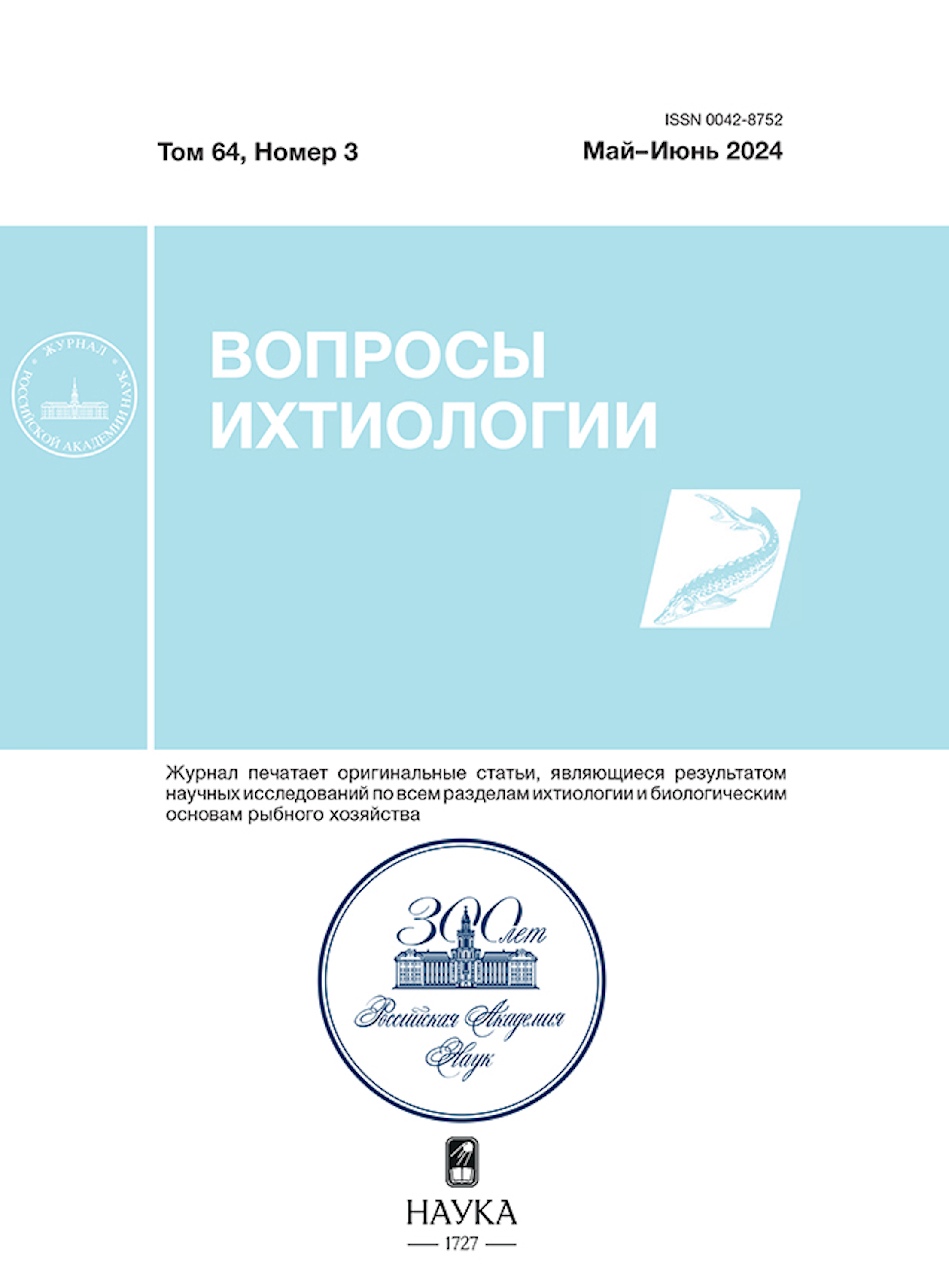Том 64, № 3 (2024)
Статьи
Происхождение, филогения и таксономия ленков рода Brachymystax (Salmonidae): имеющиеся данные, их интерпретация, нерешённые проблемы
Аннотация
На основании анализа 30 аллозимных локусов и двух фрагментов (411 и 987 пар нуклеотидов) контрольного района митохондриальной ДНК рассмотрены репродуктивные и филогенетические взаимоотношения ленков рода Brachymystax. Подтверждено наличие трёх филогенетических групп ленка: тупорылого и острорылого с территории России и сопредельных стран, а также циньлинского из Китая и Южной Кореи. Предполагается, что центром происхождения рода Brachymystax было Приморье и тупорылый ленок этого региона наиболее близок к предковой форме. Современные предположения по таксономическому статусу разных форм ленка противоречивы как по числу видов (от одного до пяти), так и по их составу. Наиболее обосновано выделение двух-трёх видов в роде Brachymystax. Указаны основные проблемы, которые необходимо решить для уточнения филогении и таксономии представителей этого рода.
 255-269
255-269


Находка второго органа Канестрини у видов вьюновых рыб (Cobitidae), характеризующихся наличием одной lamina circularis на первом ветвистом луче грудного плавника зрелых самцов. Атавизм или новообразование?
Аннотация
Дополнительный орган Канестрини обнаружен у отдельных самцов Cobitis lutheri, C. derzhavini и Misgurnus chipisaniensis, в норме имеющих одну lamina circularis на первом ветвистом луче грудного плавника. Данный факт рассматривается как проявление атавизма. В случае с C. lutheri и C. derzhavini имитируется состояние, наблюдающееся в линии Bibarba, в случае с вьюном – Bicanestrinia. Предполагается, что примитивным предковым состоянием для всей “северной клады” вьюновых следует считать наличие двух или даже трёх laminae circularis в грудном плавнике половозрелых самцов. В большинстве линий это состояние утрачено, но у предка группы Bicanestrinia, вероятно, произошла филогенетическая реверсия через фиксацию атавистического состояния как нормы.
 270-276
270-276


Суточная и сезонная изменчивость покатной миграции молоди горбуши Oncorhynchus gorbuscha (Salmonidae) в реках Сахалино-Курильского региона
Аннотация
Представлены результаты четырёхлетнего изучения покатной миграции молоди горбуши Oncorhynchus gorbuscha в реках Большая Хузи, Малая Хузи, Лазовая и Вознесенка на восточном побережье о-ва Сахалин и в р. Рыбацкая на о-ве Итуруп, находящихся далеко друг от друга в меридианном направлении (между 45° и 51° с.ш.) и в разных климатических районах. Почти вся молодь мигрировала в течение двух месяцев – мая и июня. Во всех реках отмечены сходные тенденции в динамике суточного ската молоди, связанные с сокращением периода её массовой миграции в тёмное время суток по мере приближения к дате летнего солнцестояния. В закономерный характер изменений численности покатников (фазы подъёма и спада покатной миграции) в течение сезона в связи с температурным и уровневым режимами воды в реках в условиях весеннего потепления существенные коррективы вносят особенности климатических районов (сроки и степень потепления, большее количество дождевых осадков в южных широтах). Как следствие, связи интенсивности ската молоди с температурой и уровнем воды в реках ослабевают в большей мере в южных районах в результате кратковременных изменений погоды, носящих случайный характер в отношении силы и времени своего воздействия.
 277-293
277-293


Протяжённость нерестовой миграции Байкальского омуля Coregonus migratorius (Salmonidae: Coregoninae) в реке Селенга (бассейн озера Байкал)
Аннотация
Приведены результаты исследования распределения икры байкальского омуля Coregonus migratorius в крупном предгорном водотоке Сибири в 1935–2022 гг. Протяжённость нерестовой миграции омуля в р. Селенга, отдельные параметры которой учтены с 1920 г., зависит от определённого сочетания комплекса абиотических факторов среды, биологических показателей производителей, сроков захода в реку и численности их нерестового стада. Протяжённость миграции имеет высокую обратную связь со степенью зрелости производителей, выражаемую коэффициентом зрелости самок омуля, а также со сроками захода стада в реку и расходом воды в начале миграции (сентябрь). Чем выше зрелость половых продуктов производителей, тем меньше миграционный путь, и наоборот. Кроме того, зрелость производителей определяет и сроки (дату) захода стада в реку: менее зрелые особи заходят в реку раньше и распределяются на более высоких по течению нерестилищах, более зрелые заходят позже и нерестятся ниже по течению реки. При уменьшении расхода воды р. Селенга в сентябре протяжённость нерестовой миграции омуля увеличивается и, напротив, при увеличении стока воды уменьшается. И, наконец, длина нерестового пути омуля в Селенге определяется численностью нерестового стада: чем выше количество производителей, тем больше необходимо им площадей для нереста и тем длиннее нерестовый путь. Температура воды не влияет на протяжённость нерестовой миграции омуля; нерестовый ход проходит на фоне понижения температуры воды в реке.
 294-311
294-311


Первые сведения о распределении, некоторых чертах экологии и размерном составе зайцеголового терпуга Hexagrammos lagocephalus (Hexagrammidae) в юго-западной части Берингова моря в зимне-весенний период
Аннотация
По материалам, собранным в ходе мониторинга донного тралового промысла, впервые представлены данные о распределении, термических условиях обитания и размерном составе зайцеголового терпуга Hexagrammos lagocephalus в юго-западной части Берингова моря в зимне-весенний период. Основные места поимок этого вида локализованы на участках со сложным рельефом дна, преимущественно у выступающих мысов на глубинах 134–498 м при температуре придонного слоя воды 0.5–3.8°С. Высокие значения частоты встречаемости и уловов в феврале–марте отмечены в диапазоне 201–400 м, в то время как в апреле–мае зафиксирована постепенная миграция части рыб на шельф. Установлено, что зайцеголовому терпугу не присущи пространственные изменения размерного состава, а основу уловов формируют среднеразмерные особи абсолютной длиной 39–47 см. Результаты анализа зависимости длина–масса тела рыб юго-западной части Берингова моря в сопоставлении с таковой для тихоокеанских вод Камчатки и северных Курильских о-вов могут указывать на сходный характер роста зайцеголового терпуга в смежных акваториях.
 312-320
312-320


Карликовая мальма Salvelinus malma (Salmonidae) из горных озёр субнивального пояса Камчатки
Аннотация
Гольцы рода Salvelinus (Salmonidae) демонстрируют спектр вариантов гетерохроний онтогенеза, приводящий к появлению контрастных внутривидовых фенотипов. Мы исследовали жилые изолированные популяции гольца-мальмы Salvelinus malma из холодноводных озёр субнивальной зоны Камчатки и обнаружили ранее не описанный для вида тренд педоморфоза. Специализация связана с торможением соматического роста в сравнении с широко распространённой на Камчатке проходной и озёрно-речной мальмой из открытых водных систем. Молодь из изолированных озёр отличается сравнительно высокой жирностью мышечной ткани. При этом темпы полового созревания и морфологической дифференциации остаются близки к таковым у мигрантной мальмы, педоморфоз в строении черепа проявляется незначительно, число сериальных элементов не снижается. Мальма из изолированных горных озёр к восьми-девяти годам не вырастает крупнее 20 см, средний возраст в её нерестовых группировках составляет 6.2 года (мигрантная мальма в среднем живёт столько же и вырастает в 1.6–2.0 раза крупнее). Карликовость возникает за малое число поколений, поскольку фенотипически сходные варианты обнаружены в популяциях возрастом как более 12 000, так и менее 400 лет.
 321-328
321-328


Распределение и некоторые аспекты биологии Lycodes brunneofasciatus (Zoarcidae) в прикамчатских водах Охотского моря осенью 2012 и летом 2016 гг.
Аннотация
Представлены первые сведения о распределении, условиях обитания, размерном составе и питании Lycodes brunneofasciatus (Zoarcidae) в прикамчатских водах Охотского моря. Высокие значения плотности распределения вида зарегистрированы на восточном склоне впадины ТИНРО и севернее Первого Курильского пролива. Глубина поимок ликода варьировала от 120 до 436 м, наибольшие показатели его относительного обилия характерны для 200–300 и 401–436 м. В исследованном районе L. brunneofasciatus преимущественно является обитателем охотоморской промежуточной водной массы, в пределах которой встречается при температуре воды у дна 0–1.8°С. В уловах этот вид представлен особями абсолютной длиной 32–72 см. В пище ликода по массе преобладают Bivalvia, Amphipoda, Gastropoda и Polychaeta.
 329-340
329-340


Питание минтая Gadus chalcogrammus (Gadidae) в эпипелагиали Берингова моря
Аннотация
Биомасса минтая Gadus chalcogrammus в западной части Берингова моря с 1982–1990 по 2006–2010 гг. сократилась почти на порядок – с 7.2 до 0.7 млн т, а в последнее десятилетие (2011–2020) повысилась до среднемноголетнего значения (4.0 млн т). В восточной части моря её изменения носили волнообразный характер с наибольшим значением в 1982–1990 и наименьшим – в 2006–2010 гг. Спектр питания минтая разнообразен и включал 16 таксономических групп гидробионтов. Основу среднегодовой потреблённой минтаем массы пищи в Беринговом море в 1982–2020 гг. составлял зоопланктон (74.1%). В различные периоды исследований годовое потребление корма варьировало от 91.1 до 373.0 (в среднем 239.3) млн т/год. Значительные флуктуации в объёме потребляемой пищи в основном связаны с динамикой биомассы вида.
 341-353
341-353


Двигательная активность интактного и зрительно депривированного сенегальского многопёра Polypterus senegalus (Cladistia) при разной температуре воды
Аннотация
Впервые оценена двигательная активность интактного и зрительно депривированного сенегальского многопёра Polypterus senegalus при разной температуре воды (20, 25, 30 и 34°С). С использованием метода “открытое поле” показано, что у интактных рыб с ростом температуры двигательная активность повышается (наиболее быстро в интервале 20–25°С) и достигает максимума при температуре 30°С, которая может быть близкой к температурному оптимуму (или соответствовать ему) для сенегальского многопёра. У зрительно депривированных рыб двигательная активность максимальна при 20°С и с повышением температуры монотонно снижается, все показатели двигательной активности (частота пересечений тест-линий; время, затраченное на пересечение тест-линии; проплываемое рыбой расстояние, скорость плавания) у зрительно депривированных рыб варьируют слабее, чем у интактных. Обнаруженные различия в поведении интактных и зрительно депривированных рыб указывают на наличие функциональной взаимосвязи между зрением и двигательной активностью у эволюционно древних Cladistia.
 354-362
354-362


Проблемы ДНК-штрихкодирования пузанковых сельдей рода Alosa (Alosidae) Понто-Каспийского бассейна
Аннотация
Многочисленные исследования показывают, что видовая идентификация представителей рода Alosa с применением различных генетических маркеров зачастую проблематична и требуется поиск более специфических биомаркеров. Впервые проведён анализ полиморфизма фрагмента гена СОI митохондриальной ДНК двух представителей указанного рода (A. tanaica, A. kessleri), дополненный новыми данными по A. immaculata, из вод Понто-Каспийского бассейна в сравнительном аспекте с другими представителями сельдевидных (Clupeoidea) родов Alosa, Clupea, Clupeonella, Sprattus и Sardinops. Главным результатом стало заключение, что внутри рода Alosa идентифицировать виды с помощью использованного маркера не представляется возможным. С одной стороны, образцы, отобранные от морфологически различающихся особей и идентифицированные как разные виды, имеют одинаковые гаплотипы. С другой – образцы, относящиеся к разным видам, различаются между собой на незначительное число нуклеотидных замен и не формируют самостоятельных клад на филограмме и гаплотипической сети. Это свидетельствует об отсутствии между исследованными образцами сельдей рода Alosa генетической дифференциации на отдельные виды и группы видов при использовании ДНК-штрихкодирования на основе гена COI. Причины подобного феномена могут быть следующие: 1) некорректная идентификация видов в уловах, поскольку пузанковые сельди (Alosidae) обладают высокой морфологической пластичностью и у многих видов основные внешние морфологические признаки зачастую перекрываются; 2) недавнее по меркам биологической эволюции время видообразования пузанковых сельдей рода Alosa; 3) различная доля межвидовых гибридов, которая в разных популяциях одного и того же вида может значительно варьировать.
 363-376
363-376


КРАТКИЕСООБЩЕНИЯ
Первое обнаружение взрослой особи бопса Boops boops (Sparidae) у Кавказского побережья Чёрного моря
Аннотация
Впервые у северо-восточного побережья Чёрного моря обнаружена взрослая особь бопса Boops boops. Самец стандартной длиной 310 мм и массой 250 г выловлен в Имеретинском порту г. Сочи в декабре 2022 г. На основе анализа сведений литературы об упоминании вида у российских берегов Чёрного моря выдвинуты предположения о причинах присутствия ранее обнаруженных икры и личинок бопса в пробах ихтиопланктона у берегов Крыма и Кавказа.
 377-380
377-380













